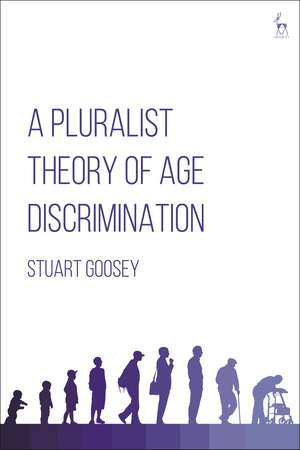A Pluralist Theory of Age Discrimination
Autor Dr Stuart Gooseyen Limba Engleză Paperback – 19 oct 2022
| Toate formatele și edițiile | Preț | Express |
|---|---|---|
| Paperback (1) | 256.38 lei 6-8 săpt. | |
| Bloomsbury Publishing – 19 oct 2022 | 256.38 lei 6-8 săpt. | |
| Hardback (1) | 539.25 lei 6-8 săpt. | |
| Bloomsbury Publishing – 27 ian 2021 | 539.25 lei 6-8 săpt. |
Preț: 256.38 lei
Preț vechi: 330.59 lei
-22% Nou
Puncte Express: 385
Preț estimativ în valută:
49.06€ • 51.46$ • 40.84£
49.06€ • 51.46$ • 40.84£
Carte tipărită la comandă
Livrare economică 01-15 aprilie
Preluare comenzi: 021 569.72.76
Specificații
ISBN-13: 9781509944071
ISBN-10: 1509944079
Pagini: 216
Dimensiuni: 156 x 234 mm
Greutate: 0.31 kg
Editura: Bloomsbury Publishing
Colecția Hart Publishing
Locul publicării:London, United Kingdom
ISBN-10: 1509944079
Pagini: 216
Dimensiuni: 156 x 234 mm
Greutate: 0.31 kg
Editura: Bloomsbury Publishing
Colecția Hart Publishing
Locul publicării:London, United Kingdom
Caracteristici
Provides a model to establish discriminatory treatment in employment, healthcare and other sectors
Notă biografică
Stuart Goosey is Lecturer at the University of Leeds School of Law.
Cuprins
1. IntroductionI. Age as a Protected Characteristic II. The Value of a Theory of Age Discrimination III. Rejecting Unitary Theories of Discrimination IV. Towards a Pluralist Theory of Age Discrimination V. The Scope of this Book VI. Possible Objections to Courts and Tribunals Using a Theory of Age Discrimination in Adjudication VII. The Reflective Equilibrium Method VIII. Criticism of Reflective Equilibrium IX. The Limitations of Reflective Equilibrium X. The Structure of this Book 2. The Legal Context I. The Structure of Age Discrimination Law II. Proportionality as Moral ReasoningIII. The Possible Implications on Age Discrimination Law of the UK Exiting the European UnionIV. The Proportionality Test in UK Age Discrimination Cases V. Conclusion 3. Equality Principles I. A Starting Point for Understanding Equality II. Strict Equality of Outcome III. Equality of Opportunity IV. Choice and Moral Responsibility V. Problems with equality of Opportunity VI. Social Equality VII. Equality of What? VIII. Conclusion 4. The Wrongs of Discrimination I. Rejecting Unitary Theories of Discrimination II. Explaining the Wrong of Discrimination III. Conclusion 5. Forming a Pluralist Theory of Age Discrimination I. A Background Theory of Age and Ageing II. The Efficiency Value of Age-Based Social Organisation III. Age Discrimination and Equality of OpportunityIV. Age Discrimination and Social Equality V. Autonomy and Age Discrimination VI. Age Discrimination and Disrespect VII. Conclusion 6. Legislative History of Age Discrimination Law and Its Relevance to Interpreting and Applying the Equality Act 2010 I. The Legality of Using Legislative History in Adjudication II. Legislative History of Age Discrimination Law III. Using the Legislative History as Aids in Adjudication IV. Evaluating the Approach to Age Discrimination Revealed in the Legislative History V. Conclusion 7. The Pluralist Theory of Age Discrimination and Age Discrimination Claims I. A Preliminary Account of How the Pluralist Theory of Age Discrimination can Assist Age Discrimination Claims Stage 1: Does the Impugned Treatment Engage the Direct or Indirect Age Discrimination Provisions? Stage 2: Is the Impugned Treatment Suitable for Achieving a Legitimate Aim? Stage 3: Is the Treatment Necessary to Achieve the Legitimate Aim? Stage 4: Is the Seriousness of the Interference with the Claimant's Interests Proportionate to the Benefits Gained in Pursuit of the Legitimate AimII. Visual Representation of the Four Stages of Settling Age Discrimination Claims III. Comparing and Contrasting the Approach of the Pluralist Theory of Age Discrimination to the Approach Adopted by the UK Cases A. Seldon v Clarkson Wright and Jakes B. Lockwood v Department of Work and Pensions & Anor C. White v Ministry of Justice D. Homer v Chief Constable of West Yorkshire E. Woodcock v Cumbria Primary Care Trust IV. Conclusion 8. Healthcare Rationing and the Pluralist Theory of Age Discrimination I. NICE's Anti-discrimination Duties under the Equality Act 2010 II. NICE's Use of the QALY Method can Engage the Indirect Age Discrimination Provisions III. The Proportionality of the QALY Method Stage 1: Does the QALY Method Pursue a Legitimate Aim? Stage 2: Is the QALY Method Necessary to Achieve the Legitimate Aim? Stage 3: Is the Gain in Efficiency Secured by the QALY Method Enough to Justify the Disadvantaging Impactof the QALY Method on Older People? IV. Conclusion 9. Conclusion I. Summary of the Pluralist Theory of Age Discrimination II. How the Pluralist Theory Assists in Age Discrimination Claims III. The Role of Moral Reasoning in Adjudication IV. How I Arrived at the Pluralist Theory of Age DiscriminationV. The Value and Limitations of Reflective Equilibrium as a Method for Investigating Legal Issues VI. The Implications for the Pluralist Theory of Age Discrimination for Understanding the Concept of Discrimination More Generally VII. The Usefulness of the Pluralist Theory of Age Discrimination in Relation to Systems Other than the UK VIII. The Value of the Pluralist Theory of Age Discrimination for Identifying which Grounds should be Protected under Discrimination Law IX. The Pluralist Theory of Age Discrimination and Political Debate
